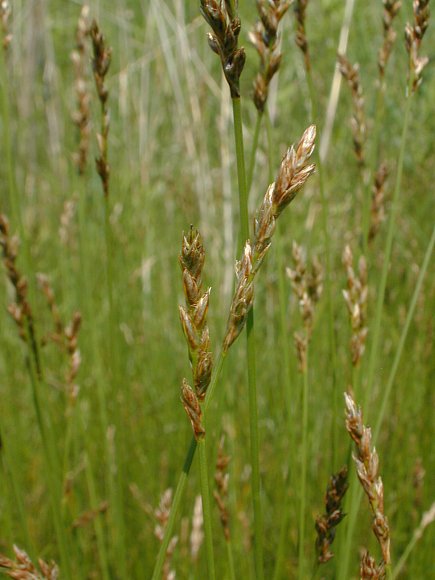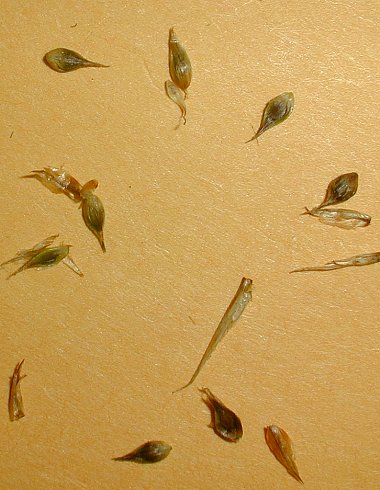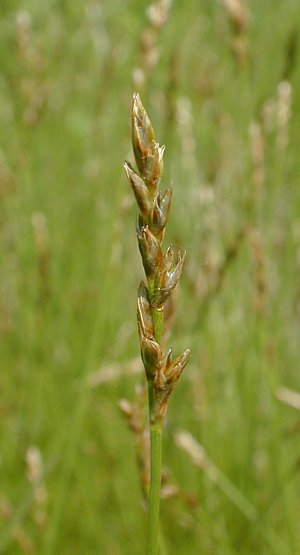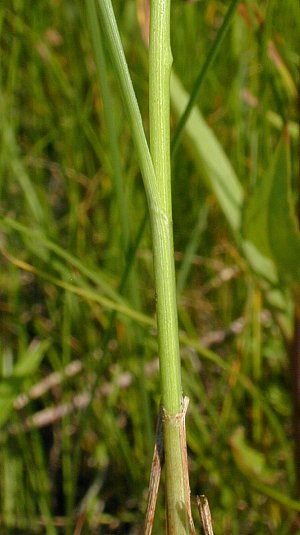Description: This perennial sedge is 1–2¼' tall, consisting of an unbranched culm with 1-4 leaves along the lower-third of its length; by the time that the inflorescence of the culm develops, the older leaves are often withered. Basal sheaths of these withered leaves often persist at the base of the culm; they are pale brown to black. Each culm is light green to green, glabrous, and triangular in cross-section (becoming more terete near the bottom); it is rough underneath the inflorescence, otherwise its texture is smooth. The narrow leaf blades are 1-3 mm. across and up to 8" in length; they are ascending to arching, green, hairless, and somewhat stiff. The sheaths of younger leaves are light green to green, hairless, and slightly concave at the apices of their inner sides. A culm usually terminates in a narrow inflorescence that is about ½–1¾" long. This inflorescence is stiff and erect, consisting of about 6-14 short spikelets that are either appressed and erect or ascending along the rachis. These spikelets are overlapping or slightly separated from each other; they tend to be more crowded toward the top. Young spikelets are a mixture of green and brown, but they later become brownish black. In addition to spikelets, the inflorescence has one or more floral bracts that are bristly-linear to scale-like. These bracts are light brown or golden brown.

The inflorescence can have spikelets with male florets above and female florets below, or spikelets with all male florets, or spikelets with all female florets; this varies with the local population. The perigynia are 2.0–3.5 mm. long and 1.0–1.5 mm. across; they are golden brown to brownish black, flattened-ovoid to flattened-lanceoloid with slender beaks, rounded at their bottoms, and lacking membranous wings along their margins. The outer surface of each perigynium has a few longitudinal veins, while its inner surface is without veins. The pistillate scales are ovate with slender tips; they are equal to, or larger than, their perigynia. These scales have greenish brown central veins, otherwise they are membranous (translucent to light brown). The blooming period occurs from late spring to mid-summer, lasting about 1-2 weeks. The florets are cross-pollinated by the wind. The achenes are broadly ellipsoid, somewhat flattened, light to dark brown, about 1.25–2 mm. long, and 1–1.5 mm. across. The root system is fibrous and long-rhizomatous. This sedge is not densely tufted at the base. Instead, individual culms are produced from the long rhizomes. As a result, a dense mat of clonal plants is produced. The culms of such colonies are normally erect, although they can lean over to one side in response to flood waters or another disturbance.

Cultivation:
This sedge is typically found in full sun and soil that wet to moist.
It also tolerates salty and/or highly alkaline
conditions to a greater extent than many other plants.
Range & Habitat:
Expressway Sedge may be native to a few counties in northern Illinois,
where it was originally quite rare (see Distribution
Map).
However, in
recent years this sedge has become more abundant because of the
application of road salt. As a result, the range of this species has
expanded southward and eastward in Illinois and other areas of the
United States. This sedge is found primarily in the western half of the
United States, where it is native. Habitats include
wet to moist prairies, prairie swales, low areas along railroads,
roadside
ditches, and low areas in the median strips of highways. In drier areas
of western United States, this sedge is typically found in alkaline and
brackish wetlands. In California,
this species has been used experimentally as a substitute for
conventional turf grass.

Faunal Associations: Grasshoppers that feed on Expressway Sedge and other sedges (Carex spp.) in wetlands include Orphuella speciosa (Pasture Grasshopper), Stethophyma celata (Otte's Sedge Grasshopper), Stethophyma gracile (Graceful Sedge Grasshopper), and Stethophyma lineata (Striped Sedge Grasshopper); see Wyoming Agr. Exp. Sta., 1994; Capinera et al., 2004). Caterpillars of the butterfly Satyrodes eurydice (Eyed Brown) feed on the foliage of wetland sedges, as do the caterpillars of such skippers as Euphyes conspicuus (Black Dash), Euphyes vestris (Dun Skipper), and Poanes massasoit (Mulberry Wing). Other insect feeders include semi-aquatic leaf beetles (primarily Plateumaris spp.), billbugs (Sphenophorus spp.), seed bugs, plant bugs, Sipha flava (Yellow Sugar Cane Aphid), and other aphids. The seeds of wetland sedges are an important food source for waterfowl, rails, and some granivorous songbirds (see Bird Table). Sedges are eaten to a limited extent by mammalian herbivores, but they are not preferred as a source of food. When Expressway Sedge and other sedges form dense colonies, this provides protective cover for many small animals and invertebrates.
Photographic Location: A drainage ditch along a highway in Savoy, Illinois.

Comments: This unusual sedge looks like a species of grass (Poaceae), but it isn't. After the seedheads disarticulate from the culms, it even resembles one of the spike rushes (Eleocharis spp.), forming the same dense mats of culms in wetland areas. However, this species has the same reproductive structures as other sedges (Carex spp.), including the perigynia and pistillate scales of the female florets. Expressway Sedge has only a few narrow leaves (3 mm. across or less) and its inflorescence is rather small. The perigynia become blackish brown during an early stage of development when those of other sedges are still green or yellow, and they are largely covered by the pistillate scales. Because of these characteristics, Expressway Sedge resembles few other sedges. One of them, Carex sartwellii (Sartwell's Sedge), is a taller plant with wider leaves (3-5 mm. across) and a somewhat longer inflorescence (¾–3" long). It produces more sterile shoots than Expressway Sedge.